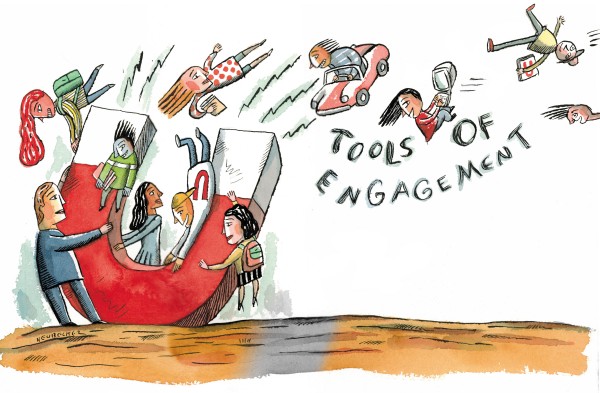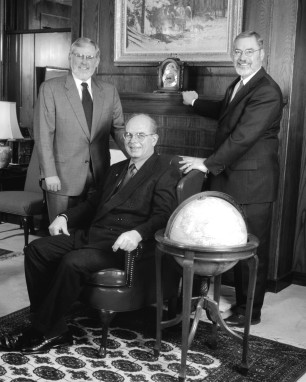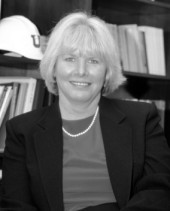
VOL. 10 NO. 1 THE MAGAZINE OF THE UNIVERSITY OF UTAH SUMMER 2000

by Byron Sims
'Got a minute?' is a new approach as U seeks to attract, retain its students.
To many, the word "engagement" may conjure up visions of nuptials or a military clash. But to educational administrators, it means a new and comprehensive approach to a vexing problem: how to attract and retain students, and thus stem the drain of dropouts.
At Utah, a commuter school where more than half the students work and where a fair number have already established homes and families, the effort to extend students' time on campus is challenging, but necessary.
"The real reason students leave is that we have failed to significantly engage them in the campus community," comments Jerry Supple, president of Southwest Texas State University, in a Chronicle of Higher Education article on efforts by colleges and universities to boost retention rates. The article notes that dropout rates are starting to decline after hitting an all-time high two years ago.
Bernie Machen, now in his third year as U of U president, has made clear his concern over student retention, believing it is an indicator of a school's ability to satisfy its students. Utah's rate of retention, about 62 percent, ideally would be in a 70 percent range.
Consequently, there is a movement afoot to sharpen the ways in which the U engages students and enhances their time on campus. Machen thinks the University should offer a "signature experience" by providing programs and opportunities either unique to the U or not widely found elsewhere. Some examples are the Bennion Center's service-learning offerings and related fieldwork, the Undergraduate Research Opportunities Program, and Washington, D.C., internships arranged through the Hinckley Institute of Politics.
 |
|
Top of the Line: President Bernie Machen with senior vice presidents David Pershing, left, and Dr. Lorris Betz. Photo by Brad Nelson |
Engagement is generally associated with such words as community, connection, and collaboration, which may then lead to terminology a bit more arcane: data-driven decisions, co-curricular components, subsets of the overall population, cluster courses, right-sizing, distance learning, and enrollment management. They are all elements of an evolving program at the U.
At the initial point of implementation are two senior vice presidents who, with Machen, form a first-time triumvirate in the U's administrative hierarchy. David Pershing, responsible for academic affairs, joined the faculty in 1977 and ten years later was, at age 39, the youngest dean of engineering in the nation. He is a Distinguished Professor of Chemical and Fuels Engineering and served as associate dean of the Graduate School. Dr. Lorris Betz, who heads the Health Sciences Center, came to Utah from Michigan. He was a professor of neurosurgery and anatomy, and held several administrative positions, including an interim deanship at Michigan's medical school. Pershing and Betz have launched strategic planning initiatives in matters that include, but are not limited to, student retention.
The principal points of contact and collaboration, however, fall within the offices of academic affairs and student affairs. Barbara Snyder, vice president for student affairs, and John Francis, associate vice president for undergraduate studies, are two of several key administrators who are spearheading the use of "tools of engagement."
 |
"We should be sure we're telling students their education should be central, but we should also deliver it in a way that makes it easier to complete." —John Francis, associate vice president, undergraduate studies |
Snyder came to Utah from the University of Nebraska less than a year ago. During her first week on campus she was asked what her chief initiatives were. "I said I'd put them together, subject to change," she says. "But they haven't changed much at all."
In recent months she's outlined the list of initiatives to her student affairs staff, several academic units, the University Senate, and the University's National Advisory Council. Major points of emphasis are building community, becoming a premier residential campus, serving a commuter-student population, and being what we say we're going to be. The issues of recruiting, retention, and enrollment management are folded into these areas, with an overlay of connection and collaboration.
Snyder also says the University is participating in a National Survey of Student Engagement involving nearly 195,000 students at 275 colleges and universities. The inaugural project is designed to focus attention and discussion "on things that really matter to quality undergraduate education: what students do and what they say about their experience," according to an NSSE brochure. Once the survey is completed, participating schools will receive an analysis of results along with an institutional profile and a data file on responses by its students.
"To build community—and I've heard about the lack of it loud and clear from students—we need data," Snyder asserts. "We are trying to take a decentralized university and break it into manageable parts. Much of our present data is based on full-time, first-year freshmen, which is a subset of the student population, and not even the largest subset."
John Francis, a faculty member for 26 years who continues to teach a class in European politics in addition to his administrative duties, says, "Our students lead enormously busy lives, many with obligations of work and family. They are largely interested in when and where classes are offered. This year we required incoming students to go to orientation and told them to see an academic adviser if they wanted priority registration. We have now doubled the number who seek advice and are tracking their eventual outcome."
In addition, Francis notes that the Liberal Education Accelerated Program—a first-year offering to those wishing to fulfill many of their graduation requirements—is available to everyday, non-honors students, and that LEAP instructors take a deep interest in participants, both in and beyond the classroom. Consequently, he says, "The retention rate among these students is enormous, almost double the University average."
Next fall, the U will schedule a series of three or four "cluster classes," Francis points out. One of them—Western Landscapes—will combine geology, literature, and environmental ethics classes, thus satisfying three general education requirements. The cluster concept will also be included in service-learning offerings.
A way of measuring performance, Francis explains, "is having students produce something distinctive, whether a service-learning undertaking, an honors thesis, a piece of choreography, or an engineering project. We want them to find that at a research university they have an opportunity they wouldn't find at another school."
Administrators agree that tracking student progress and more closely defining the makeup of the U's student population will eventually lead to better data-driven decisions. Such steps, says Francis, also reflect Vice President Pershing's strong feeling that students should be considered consumers; that is, a population to be served and satisfied.
 |
"[Heritage Commons] is going to bring an absolutely remarkable transformation to this campus." —Barbara Snyder, vice president, student affairs |
Pershing's view is substantiated by Betsy Barefoot, co-director of research and publication at the University of South Carolina's National Resource Center for the First-Year Experience. "There's more of a consumer mentality among students now, and less of a sense of institutional loyalty," says Barefoot in the Chronicle article.
Pershing is also pushing to eliminate bottlenecks in how students acquire credits to complete their academic programs. "Measurements have been structured so that it was assumed any extra credits students earned were because they had a problem getting the classes they wanted," he says. "Actually, they earned extra credits because they changed [academic] directions. The University is a place for broadening one's understanding. But extra learning was being discouraged as a 'bad' thing since it took more time."
As for the U becoming a premier residential campus, that essentially means planning for the acquisition of Heritage Commons, the new facilities at Fort Douglas, and their exciting potential for providing Machen's idea of a "signature experience." Built for use as the Olympic Athletes Village, the facilities become the property of the U after the 2002 Games.
"[Heritage Commons] is going to bring an absolutely remarkable transformation to this campus," Snyder exclaims. "All programs around the country that are significantly improving student retention have living-learning components in their residence units."
Snyder and Francis recently visited these kinds of programs at Maryland, Virginia, Missouri, and Georgia Tech. "Missouri has been offering a fantastic living-learning program for 20 years," says Snyder. "Their retention rates are soaring, and their retention among students of color is higher than the overall campus average, something you'd certainly aspire to."
These visits also paid off in other ways, such as generating ideas for serving Utah's mobile student population. "Maryland has the model for commuter-student programs," Snyder explains, "and serves as a national information clearinghouse. They even supply their frontline people—faculty, staff, and advisers—with tips on being commuter-friendly.
"Most people don't think of a flagship university as being such a heavy commuter campus or having so small a percentage of residential students," Snyder says of the U. "In that respect, perhaps only the University of Washington is closely similar."
"Many students," says Francis, "arrive in the morning, go to class, and then they're gone to a job or whatever. We'd like to find ways to engage them and keep them on campus longer, whether through innovative programs, after-class interaction with faculty, or by encouraging them to do more work at home electronically. Extending their time on campus is all part of building community.
"We should make sure we're telling students their education should be central, but we should also deliver it in a way that makes it easier to complete."
The initiative of "being what we say we're going to be" centers on what Snyder maintains is the lack of a consistent, marketable University image, although she admits "some of my colleagues don't agree with this notion." Regardless, she and Fred Esplin, the U's vice president for university relations, are part of a working group structuring a campaign to showcase the University in selected markets.
In Snyder's view, there is also a perception-of-cost versus reality issue to contend with. Comparatively, "the U is a bargain...a bargain," she stresses, "even though most students don't think so. We're still a best-kept secret. But we do need to strengthen our scholarship support."
Should the state's student population decline over the next decade, as projections indicate, the U will need to attract and retain more students. And distance education through satellite campuses, learning centers, and TV- and Web-delivered courses will likely gain even greater prominence.
Yet, as Bernie Machen frequently says, if students are qualified to attend the University, they should come in as freshmen, not transfers. Within the state, there has not been enough emphasis on retention, he says, noting that "it has been sort of a badge of honor [among students] to move around to different places."
However, as Pershing, Betz, Snyder, Francis, and other colleagues put engagement plans in place, students' time at the U will likely become more meaningful, memorable, and rewarding—all the makings of a signature experience.
—Byron Sims BS'57, now retired, was founding editor of Continuum.
Copyright 2000 by The University of Utah Alumni Association